Delhi Supreme Court, and Agra Taj Mahal
Princess Bhuvanesh Kumari is a Woodstock alumna, class of 1950. She grew up in the maharajah’s palace in Patiala, in Punjab state. After Woodstock, she proceeded to earn a legal degree in England, returning to practice law in India, then admitted to practice in the Supreme Court as well. She says she prefers to write the arguments rather than debating in court.
Wednesday, Princess Bhuvanesh Kumari met us at the Y; we drove to the parliament building. Security is exceptionally tight there since the brazen daylight attack on it two years ago by Kashmiri terrorists. So our vehicles could not enter the grounds. [ed. Note: “The Week” magazine just reported that the Home Minister invited some leftist party dignitaries for a meeting to encourage them to rejoin the ruling coalition; but he neglected to get permission for their vehicles to enter the parking lot, so the guards turned them away…coalition talks will proceed, after abject apologies. Was it an intentional oversight?] We also cooled our heels in the rather nice reception building for 40 minutes; I took the opportunity to wander about, and found an obscurely located souvenir shop with parliamentary books – I ordered 6 books for our library (I figured they would not be otherwise available, and would provide our Indian Government students with some primary source/reference material),, including a book title “Unparliamentary Expressions” and a glossary of English idioms (that would help the eloquent parliamentarian seeking just the right expression to impress his colleagues; and the other book would keep him from saying anything unparliamentary. The shop also sells pens and teacups and cards emprinted with the distinctive logo of the parliament.
The parliament is a huge round stone building – thus the distinctive logo. We toured the lower house “Lok Sabha”, with its 552 seats (including 2 seats reserved for the Anglo-Indian community); the upper house “Rajya Sabha” with 250 seats, and the President’s Room with over 800 seats and much less formal, intended for joint sessions that take place at least 3 times a year. The guide also showed us the member’s reading room, and the neighboring fancy new building with a beautiful advanced library and auditorium, worthy of the World’s Largest Democracy. The parliament building itself is grand but fusty… 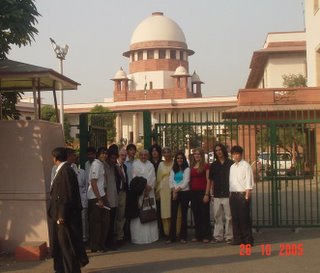 the same could be said of the Supreme Court, even more so, as it is filled with hallways and warrens and clerks and lawyers -- we had the good fortune to be escorted by Princess Bhuvanesh, who has privileges to argue cases there – she wore her official robes to escort us; and she scolded the security guard for his rudeness to us when our kids innocently brought cameras through the checkpoint.
the same could be said of the Supreme Court, even more so, as it is filled with hallways and warrens and clerks and lawyers -- we had the good fortune to be escorted by Princess Bhuvanesh, who has privileges to argue cases there – she wore her official robes to escort us; and she scolded the security guard for his rudeness to us when our kids innocently brought cameras through the checkpoint.
We sat in a hearing room – the Supreme Court has 26 judges, with 10 courtrooms where various sets of judges hear and decide cases. Our room had a 3-judge panel hearing some minor employment cases. One judge was entertainingly curt with the lawyers, berating them for lack of preparation.
This is the last week of the session, and the court has issued opinions in some big cases recently: one involving a child-custody situation where the child is in New York with her father; but the maternal grandfather (who happens to be a retired state governor) is seeking custody because of the mysterious death of the mother. The Supreme Court here grants custody to the grandfather, and asks the government to seek a diplomatic solution because the New York court has granted custody to the father. More importantly the court recently reprimanded the government for holding on to the property of a maharajah’s family, and for allowing dozens of officials to live rent-free in govt. housing, beyond their official entitlement. The newspaper published photos of several prominent scofflaws and their nice houses!
She then took us to the court’s museum building, a rather sparse exhibit that strives to prove the glorious long tradition of justice in India – though almost all of its current institutions date from the British times.
We drove then to the American Center – what used to be known as the USIA, then USIS, and now the ARIC – American Resources Information Center. It has evolved into a simple library: a reading room for the public, and a subscription lbirary for borrowers. They also offer filmshows and meeting rooms for members. The Woodstock principal has a membership,we discover – but the school should be an institutional member as well – I hope to remedy that soon.
By 5pm we drove back to the Y, and let the students have free time for dinner – Miss Chander and I drove to Berco’s Chinese restaurant, in Connaught Place, block E – a little expensive total bill, but very nice restful atmosphere and very pleasant service. The food was allright, though I forgot my rule of thumb in Indian cuisine: always ask for “not-spicy” dishes. Even the dish that the manager characterized as not very spicy ended up being unpleasantly hot after my bowl of Thai soup with chilies. What a wimp!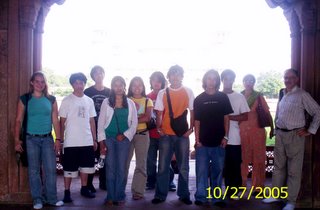
27 October, Thursday
The front desk phoned at 4:30a.m., to wake me up for our 5am departure for Agra. The four girls were ready to go at 5, but the 6 boys just woke up at 5! A few minutes later, we drove off in the pre-dawn darkness. What a cool pleasure to drive the Delhi streets with no traffic – because many of the intersections are (British-style) roundabouts, there are few traffic signals to slow you down. The road to Agra is mostly quite good four-lane divided highway, recently paved. The driver would occasionally reach 120kph, rather wild, given that most of the road also has camel-drawn or horse-drawn or ox-carts, or tractors pulling huge loads of bricks; periodically peasants cross the road carry bundles of wood, or water jugs. Our driver still lays a heavy hand on the horn, and seems especially wary of intersections and potholes.
The air is thick with haze, from the heat and dust and smoke. In October, the mid-day hours are still blazing hot. I cannot imagine living through a summer here, especially without air-conditioning. It seems quite an inhospitable place to build a city – perhaps a mausoleum is more appropriate? We visit three mausoleum sites today: Akbar’s, the Taj mahal, and Itm-ad-daula. 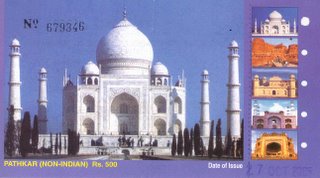
All are spectacular constructions, well-preserved (though actually restored 100 years ago to a considerable extent.
The Taj Mahal is of course stunning, but the surrounding maze of hawkers and touts and dirt is awful. The lack of signage places tourists (both local and foreign) at the mercy of the semi-official guides. 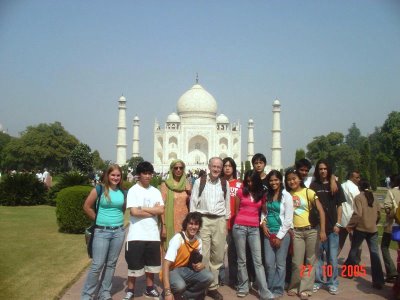
Today the majority of the tourists are local – that is, Indian citizens viewing their patrimony. Warning: everything sold outside the Taj is highly and easily negotiable: the guides have cards noting that the price is Rs375. We quickly agreed on Rs50 for one guide’s service for the hour. Try to ignore the incessant sales pitches and plow ahead to the front gate, and pay the special foreigner price… the government apparently decided to price all archeological sites at par for the tourists. That is, 5 rupees for Indian citizens; 5 dollars for foreigners. At the Taj, it’s 20/20 (in practice, Rs20 for the locals; Rs750 for others). 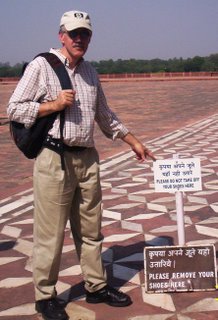 But the foreigner’s price gets you a free bottle of water, and some paper booties for your shoes, so you don’t have to run the shoe-locker gauntlet before entering the sanctuary. Security is again tight – they do not allow any electronic devices on the property, except for cameras. Leave them in your car. Note also that there is a moderately-priced restaurant on the grounds, next to the souvenir shop that the guides will steer you to. Those marble inlay products are gorgeous, but expensive.
But the foreigner’s price gets you a free bottle of water, and some paper booties for your shoes, so you don’t have to run the shoe-locker gauntlet before entering the sanctuary. Security is again tight – they do not allow any electronic devices on the property, except for cameras. Leave them in your car. Note also that there is a moderately-priced restaurant on the grounds, next to the souvenir shop that the guides will steer you to. Those marble inlay products are gorgeous, but expensive.
Again, the Taj and its several accompanying buildings are spectacular, but the crowds and the accompanying dirt and sales pitches makes the experience unpleasant.
Far better is the Itm-ad-dullah, the tomb of the Taj builder’s grandparents – it is off the beaten track, on the opposite side of the Yamuna River – we found only a few visitors there, and only one mild photo-seller. The building is smaller, but the stonework is elaborate and all the more beautiful because of its accessibility. A patio overlooking the river would be a most pleasant place to while away a few hours.

Departing hot and dusty and crowded Agra by 4pm, we hit the road, and stop at… McDonald’s, modeled after the big highway rest stops (except that there’s no play room), with even a Drive-Thru window! Also, the fast-food franchises in India typically play loud pop music. And there’s a substantial vegetarian menu, not just a Veggie Burger – a potato patty burger, and a cheese-cube wrap and a veggie cheese pizza puff. And no apple pie. And, umm, no beef. Fish and chicken, no problem. But McDonald’s does not include the usual beef-like substitute of lamb. You were wondering about the prices? Roughly equivalent, using my practical exchange rate. But for the American tourist, it’s cheap.
The heat saps our energy, producing an exhausted group of Woodstock teachers and students. We get back to the Y at 8:30, tell the kids they should stay on the grounds – most order pizza delivered. I took the opportunity to shower, then walk up the street to the Park Hotel—a world of difference! Though not quite as cool or iinviting as I had expected. The maitre d’ was friendly when I asked for a beer and snack – he ushered me through the restaurant to the bar. It was, again, modern, but not very cool or inviting, and the prices were easily the same as (in my recent experience) an urban chic hotel in Washington DC…even using the official rate of exchange! I passed it up, though not before finding that the youthful maitre d’ comes from Nainital, the “other” popular hill station in Uttaranchal state.
I walked on up the block to the Kwality Restaurant, the old standby for expatriates. It was founded soon after world war II to serve American Gis, and survived through the Socialist Non-Aligned years. A cold glass of Kingfisher beer and some delicious mutton broth refreshed me for a good night’s sleep.

0 Comments:
Post a Comment
<< Home